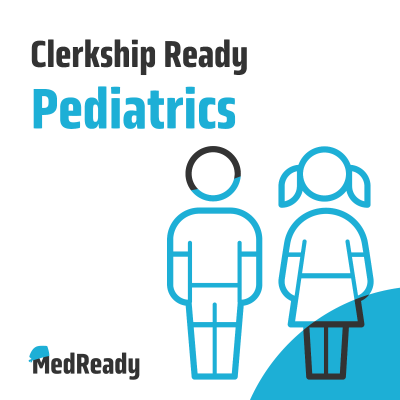
Clerkship Ready: Pediatrics
Podkast av MedReady
Clerkship Ready: Pediatrics is a podcast aimed at medical, PA, and NP students who are entering their clinical rotation in Pediatrics. It covers topics including Your Pediatric Survival Guide - Tips and Tricks, Before Your First Well-Child Check, Peds GI Clinic, and more. Each podcast walks you through a portion of what you’ll experience during your clinical rotations, gives you tips for excelling, preps you for the clinical questioning that’ll occur, and sets you up to overall Honor the rotation! Email podcasts@procedureready.com with comments, questions, and episode ideas. ##Legal Disclaimer## The opinions expressed within this content are solely the speakers' and do not reflect the opinions and beliefs of their employers or affiliates.
Prøv gratis i 7 dager
99,00 kr / Måned etter prøveperioden.Avslutt når som helst.
Alle episoder
33 EpisoderIn this episode, we will be reviewing what you need to know before your first discussion about infant formula. We will cover the characteristics and types of formulas, why infants might require different types, the correct way to prepare formula and how much infants need, common concerns from parents, indications for changing formulas, and when to transition away from it. 1. Reasons for formula feeding 1. Human milk is first choice for most infants 2. Concern about lactating parent’s milk supply 3. Workplace conditions make it difficult to sustain human milk feeding 4. Parent preference 5. There are few true contraindications to breastfeeding. 1. Galactosemia 2. Maternal HIV infection that has not achieved an undetectable viral load 3. Maternal phencyclidine (also known as PCP) or cocaine use 4. Active Herpes Simplex virus lesion 5. Active tuberculosis 2. Types of formula: 3 characteristics 1. Caloric density: calories per ounce. Standard term formula is 20 calories/oz. Infants born preterm or have growth failure may need 22-27 calories/oz. 2. Carbohydrate source: Lactose (galactose + glucose) or non-lactose 3. Protein type: 1. Cow-milk based formula proteins are whey and casein. 2. Hydrolyzed formulas: proteins are broken down into smaller protein “chunks” or into individual amino acids, which are hypoallergenic and easily digestible. 3. Other formulas utilize different sources of protein, including soy protein and goat’s milk. 4. Special formulas for infants with specific metabolic conditions: eg. phenylketonuria, maple syrup urine disease, homocystinuria. 3. Forms of formula 1. Powder: most common and least expensive. Usually, 1 scoop of formula powder is mixed with 2 oz water. 2. Liquid concentrate: mixed 1:1 with water. 3. Ready to feed: no mixing required, but most expensive. 4. Be sure that the formula is being mixed correctly! Incorrect formula mixing can result in growth failure or electrolyte abnormalities. 4. How much formula should be given? 1. A good rule of thumb is that infants require between 120-150 calories/kilogram per day. 5. Common myths about formula 1. Lactose intolerance. True congenital lactase deficiency is rare disorder and, in infants, it will usually present with very severe diarrhea. 1. What adults experience as lactose intolerance occurs later in childhood. 2. Developmental lactase deficiency can occur in premature infants, but lasts for a short time after birth and the majority are still able to consume lactose-containing formulas. 3. Infants can develop a temporary, self-resolving lactase deficiency after suffering from a gastroenteritis 2. Increased spit ups (often at around 4 months of age): Generally not a sign of formula intolerance. 3. Gassiness and stomach discomfort after feeding: Normal and usually not a reason to switch formulas. 6. Medical reasons to switch formula type 1. Galactosemia: most often diagnosed after abnormal newborn metabolic screen. 2. Milk protein allergy: usually presents with blood in stool from allergic proctocolitis. Rarely, more severe milk protein allergies can present as hives or even anaphylaxis. 3. Metabolic disorders 7. Usually stop infant formula at 1 year of age and switch to cow’s milk, usually whole milk. 1. Do not switch to cow’s milk before 1 year of age because of solute load on kidneys. Resources/Links: https://www.healthychildren.org/English/ages-stages/baby/formula-feeding/Pages/default.aspx [https://www.healthychildren.org/English/ages-stages/baby/formula-feeding/Pages/default.aspx] https://www.aafp.org/pubs/afp/issues/2009/0401/p565.html [https://www.aafp.org/pubs/afp/issues/2009/0401/p565.html] https://www.cdc.gov/nutrition/infantandtoddlernutrition/formula-feeding/choosing-an-infant-formula.html [https://www.cdc.gov/nutrition/infantandtoddlernutrition/formula-feeding/choosing-an-infant-formula.html] https://kidswithfoodallergies.org/recipes-diet/nutrition-and-health/formula-options-for-kids-with-food-allergies/#:~:text=Extensively%20Hydrolyzed%20Formulas%20(e.g.%2C%20Enfamil,common%20cause%20for%20allergy%20symptoms [https://kidswithfoodallergies.org/recipes-diet/nutrition-and-health/formula-options-for-kids-with-food-allergies/#:~:text=Extensively%20Hydrolyzed%20Formulas%20(e.g.%2C%20Enfamil,common%20cause%20for%20allergy%20symptoms].
Listen along as we dive into the many causes of sore throat. Learn about the common causes such as allergies and viral illnesses while also what to do when a child with epiglottitis comes in. We will cover CENTOR criteria as well and when you should think about Group A strep testing. Common Causes * Viral Presentation * HSV * Mononucleosis * Allergic Presentation * Group A Strep * CENTOR Criteria Emergency Causes * Peritonsillar Abscess * Retropharyngeal Abscess * Epiglottitis Wrap Up & Conclusion Resources/Links: https://www.chop.edu/conditions-diseases/throat-anatomy-and-physiology [https://www.chop.edu/conditions-diseases/throat-anatomy-and-physiology] https://www.mdcalc.com/calc/104/centor-score-modified-mcisaac-strep-pharyngitis [https://www.mdcalc.com/calc/104/centor-score-modified-mcisaac-strep-pharyngitis] References 1. Aluma Chovel-Sella, Amir Ben Tov, Einat Lahav, Orna Mor, Hagit Rudich, Gideon Paret, Shimon Reif; Incidence of Rash After Amoxicillin Treatment in Children With Infectious Mononucleosis. Pediatrics May 2013; 131 (5): e1424–e1427. 10.1542/peds.2012-1575 2. Becker JA, Smith JA. Return to play after infectious mononucleosis. Sports Health. 2014 May;6(3):232-8. doi: 10.1177/1941738114521984. PMID: 24790693; PMCID: PMC4000473. 3. Chowdhury MDS, Koziatek CA, Rajnik M. Acute Rheumatic Fever. [Updated 2023 Aug 2]. In: StatPearls [Internet]. Treasure Island (FL): StatPearls Publishing; 2024 Jan-. Available from: https://www.ncbi.nlm.nih.gov/books/NBK594238/ 4. Esposito, S.; De Guido, C.; Pappalardo, M.; Laudisio, S.; Meccariello, G.; Capoferri, G.; Rahman, S.; Vicini, C.; Principi, N. Retropharyngeal, Parapharyngeal and Peritonsillar Abscesses. Children 2022,9,618. https://doi.org/ 10.3390/children9050618 5. Martin JM. The Mysteries of Streptococcal Pharyngitis. Curr Treat Options Pediatr. 2015 Jun;1(2):180-189. doi: 10.1007/s40746-015-0013-9. PMID: 26146604; PMCID: PMC4486489. 6. MCMILLAN, J. A. , WEINER, L. B. , HIGGINS, A. M. & LAMPARELLA, V. J. (1993). Pharyngitis associated with herpes simplex virus in college students. The Pediatric Infectious Disease Journal, 12 (4), 280-283. 7. Mohseni M, Boniface MP, Graham C. Mononucleosis. [Updated 2023 Aug 8]. In: StatPearls [Internet]. Treasure Island (FL): StatPearls Publishing; 2024 Jan-. Available from: https://www.ncbi.nlm.nih.gov/books/NBK470387/ 8. Roggen I, van Berlaer G, Gordts F, et al. Centor criteria in children in a paediatric emergency department: for what it is worth. BMJ Open 2013;3: e002712. doi:10.1136/ bmjopen-2013-002712
Asthma is a common chronic disease of childhood that affects 1 in 12 children in the United States. It can range from mild respiratory symptoms to life threatening respiratory failure, with a range of treatment options in-between from the primary care setting to the pediatric ICU. In this episode, we will discuss the underlying pathophysiology, diagnosis, evaluation, and management of patients with asthma, along with some useful clinical pearls to help you take care of these patients! 1. Cause of asthma 1. Genetics: “Atopic triad” of asthma, atopic dermatitis or eczema, and allergic rhinitis 2. Prenatal and childhood environmental factors: maternal smoking and allergen exposure 2. Pathophysiology and diagnosis 1. AAP definition: “episodic and reversible airway constriction and inflammation in response to infection, environmental allergens, and irritants. It is a complex, multifactorial, and immune-mediated process that presents with various clinical phenotypes.” 2. Airway hyperreactivity leads to inflammation of bronchi, increased mucus production, bronchial smooth muscle contraction 3. Key elements of the history – recurrent episodes of cough, wheeze, difficulty breathing, nighttime symptoms, consistent trigger, atopic personal or family history, improvement with asthma treatment. 4. Identification of triggers is important. Common triggers include respiratory infections, mold or pet dander, pollen, intense crying or laughing, exercise, pollution, and cold air. 5. Children from minority and lower-income backgrounds experience an increased asthma burden, likely closely tied to a complex interaction of factors such as decreased access to healthcare, increased rates of obesity, and poor air quality in the areas in which they live. 3. Classification of asthma: determined by the frequency and severity of symptoms when they are not receiving preventative treatment. 4. New 2022 guidelines for asthma treatment 1. Albuterol or other beta 2 agonist as needed for symptoms - relaxes bronchial smooth muscles 2. Daily controller medication (usually inhaled steroid) if symptoms more than twice weekly - inhaled steroid decreases inflammation 3. Inhaled steroid + long-acting beta 2 agonist combination inhaler preferred for those >5 years 4. Asthma action plan should be given to every patient 5. Treatment of acute asthma attack 1. Quick assessment and stabilization of patient is important 2. Treat acute symptoms first, then address chronic control of asthma 3. Albuterol or ipratropium-albuterol, systemic steroids are generally first lines of treatment 4. Supplemental oxygen as needed 5. Other options for medications: magnesium, terbutaline, theophylline, epinephrine 6. Frequent reassessment is needed Resources: Global Initiative for Asthma, Pocket Guide for Asthma Management and Prevention for Adults, Adolescents and Children 6-11 Years. Updated 2023. https://ginasthma.org/wp-content/uploads/2023/07/GINA-2023-Pocket-Guide-WMS.pdf [https://ginasthma.org/wp-content/uploads/2023/07/GINA-2023-Pocket-Guide-WMS.pdf]
In this episode, we discuss lead toxicity and lead screening. We will talk about what lead is, what happens when a child is exposed to lead, what to ask parents about if you’re worried about lead exposure, how to screen for lead toxicity, and what to do if your patient has an elevated lead level. 1. Sources of lead exposure 1. Ingestion of contaminated food or water 2. Ingestion or breathing in of lead dust 3. Other sources: lead-acid batteries, ammunition, lead-based pigments and paints, stained glass, lead crystal glasses, ceramic glazes, jewelry, toys 4. For families from other cultures, think about ceramic glazes, traditional cosmetics, traditional medicines 2. Government policies to decrease lead exposure 1. Unleaded gasoline 2. Lead-free paint 3. Lead-free solder in food cans 4. Lead-free water pipes 3. Why young children are at risk for lead toxicity 1. Hand-to-mouth behavior 2. Increased absorption of lead 3. Developing nervous system is vulnerable 4. Calcium or iron deficiency increase absorption of lead 4. Effects of lead toxicity in children can be seen at levels as low as 3.5 µg/dL 1. Growth and development delays 2. Lower IQ 3. Learning and behavior problems 4. Hearing and speech problems 5. School underperformance 6. At higher levels, you may see 1. Irritability 2. Loss of appetite, weight loss, fatigue 3. Abdominal pain, vomiting, and/or constipation 4. Anemia 5. Pica 6. Seizures, coma, death 5. Universal lead screening at 1 and 2 years 1. Screening questionnaires are not very sensitive or specific 2. Blood lead test 1. Capillary – get results quickly, but can be falsely elevated 2. Venous – results more accurate, but may take some time to come back 6. Management of elevated lead level 1. Repeat it if it was a capillary sample 2. Review results with family 3. Ask about potential exposures – may need to contact health department, landlord, or independent certified lead inspector to test home for lead 4. Assess risk factors for iron or calcium deficiency 5. Ask about developmental milestones – may need to refer to early intervention services 6. Consider abdominal xray if history of pica 7. For levels >45, may need chelation therapy Resources/Links: * CDC, Childhood Lead Poisoning Prevention, https://www.cdc.gov/nceh/lead/default.htm [https://www.cdc.gov/nceh/lead/default.htm] * AAP policy statement. Prevention of Childhood Lead Toxicity, Pediatrics 2016: 138(1):e20161493. https://publications.aap.org/pediatrics/article/138/1/e20161493/52600/Prevention-of-Childhood-Lead-Toxicity [https://publications.aap.org/pediatrics/article/138/1/e20161493/52600/Prevention-of-Childhood-Lead-Toxicity] * Mona Hanna-Attisha, What the Eyes Don't See: A Story of Crisis, Resistance, and Hope in an American City, 2018. https://www.amazon.com/What-Eyes-Dont-See-Resistance/dp/0399590838 [https://www.amazon.com/What-Eyes-Dont-See-Resistance/dp/0399590838]
In this episode of Clerkship Ready – Pediatrics Dr. Jared Barkes, a Child Neurology resident at The University of Virginia, will be walking you through how to complete the neurologic exam! Throughout the episode he will cover in detail the different parts of a formal neuro exam while also providing useful tips for remembering commonly tested facts, reviewing specific examples of abnormal findings and common neurologic conditions, and offering helpful advice for completing a neuro exam on a pediatric patient. After listening to this podcast you will have all the tools necessary to shine on your first day of your neurology clerkship! * Introduction * What is the neuro exam? * Review of the “Map” of the neuro system * Cortex, Brainstem, Spinal Cord, Motor neuron * How to complete a neuro exam and what to look for! * General Assessment * Mental Status * Language * Cranial Nerves * Strength * Sensation * Coordination * Reflexes * Special consideration for pediatrics * Closing Resources/Links: * “NeuroLogic Exam”, A complete in-depth guide of the neuro exam complete with references and videos produced by Dr. Paul D. Larsen, M.D. and Suzanne S. Stensaas, Ph.D. at The University of Utah. (https://neurologicexam.med.utah.edu/adult/html/home_exam.html [https://neurologicexam.med.utah.edu/adult/html/home_exam.html]). * “PediNeurologic Exam” A guide of the neuro exam for children produced by Dr. Paul D. Larsen, M.D. and Suzanne S. Stensaas, Ph.D. at The University of Utah (https://neurologicexam.med.utah.edu/pediatric/html/home_exam.html [https://neurologicexam.med.utah.edu/pediatric/html/home_exam.html]) * Medical Student Resources from the American Academy of Neurology (https://www.aan.com/tools-resources/medical-student-educational-resources [https://www.aan.com/tools-resources/medical-student-educational-resources]).
Prøv gratis i 7 dager
99,00 kr / Måned etter prøveperioden.Avslutt når som helst.
Eksklusive podkaster
Uten reklame
Gratis podkaster
Lydbøker
20 timer i måneden



















